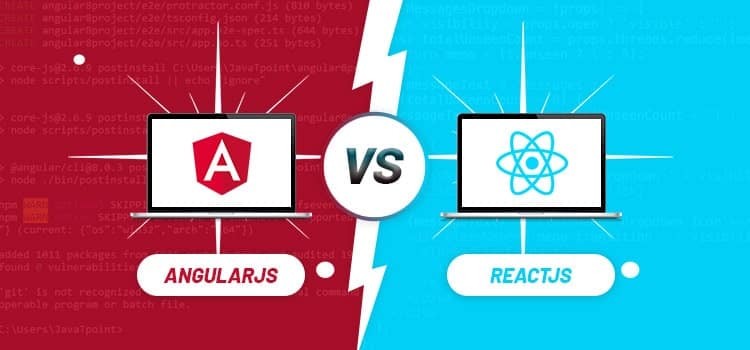In this blog, you will discover the difference between ReactJ and AngularJS which will help comprehend what you need to use for your web app. After all, realizing the right type of framework is a must in order to make sure you make it through the production in minimum time. It is important to choose the framework that suits the requirements of your project and mobilize your app. So be rest assured as you are going to find that in AngularJS vs ReactJS, which is better for your next big hot.
AngularJS Vs ReactJS- Which is Better?
Whether you navigate to the leading AngularJS development company or seek help from the clan of ReactJS developers, the end goal is to find the alignment between your expectations and the results produced. This, at last, makes it inevitable for you to see what the differences between AngularJS Vs ReactJS bear for you to shape your decision smartly. Sit back with a patient sigh and scroll through this guide where you will ultimately realize that in the light of AngularJS vs ReactJS, which is better for your project.
What is AngularJS?
Angular JavaScript is a structural framework developed by Google that uses the TypeScript language and helps develop dynamic web applications. It lets developers use the HTML as a template language and allows them to expand HTML syntax. The latest version of Angular has come up with an improved algorithm and performs 10 times faster.
The certified AngularJS developers can build web apps working on a large scale such as online booking services, eCommerce, or PWAs (Progressive Web Apps) that give a website application the behavior of a mobile app. Since it is a launch of Google and possesses a prowess of faster coding, Angular counts as one of the major JavaScript frameworks
What is ReactJS?
React is a JavaScript library that helps build user interfaces. It enables developers to create intricate UIs out of small components and these UI components are reusable. This framework is indeed efficient, flexible, and works especially for single-page applications.
Developers use React in order to compose highly functional web apps that are fast, simple, and scalable. It is dedicated to performing for the UIs of applications. Besides that, it is declarative, easy to learn, and can be used with other JavaScript libraries or frameworks.
AngularJS Vs ReactJS Comparison: Pros and Cons
Let’s dive into the details of the pros and cons of AngularJS VS ReactJS.

Pros of ReactJS
1. Easy to Learn and Use
One of the major benefits of ReactJS is its easy-to-learn operations. This framework comes armed with documentation and tutorial resources which helps an individual get their hands on it easily. For developers who come from the JavaScript clan, it is just a matter of a few days and they start creating web apps. Before going through in detail of AngularJs Vs ReactJs check more pros of ReactJs.
2. Development of Dynamic Web Apps
You can really count on a ReactJS development company if your goal is to bring a dynamic web application to the table. Gone are the days when creating a dynamically functional web app with HTML was a complex road to take. Thanks to React, it lets developers create high functionality in less dramatic coding.
3. Reusable Code
What makes reactjs sought after has a lot to do with code reusability. This framework features reusable code which opens the room for an easier way to create ReactJS web app. Know that the components in React can be nested with other components in order to make complex web app creation suited by simple blocks.
4. Better Performance
Since ReactJS incorporates virtual DOM, a cross-platform as well as programming API dealing with XML, HTML, and XHTML, there is always room for enhanced functionality. Earlier, DOM was a matter of frustration as it slowed down the app’s performance but then the virtual DOM came into the picture. The React Virtual DOM stays completely in memory and projects the DOM of the web browser which means that one can simply write virtual components instead of writing directly to the DOM.
5. Tools Come Handy
ReactJS has one more reason for becoming the foremost choice for many developers and that is the pack of handy tools it comes bearing. This is one of the reasons why React became so popular in the first place. The React developer tools help walk through the React component parties in the virtual DOM and enable developers to choose specific components which can be inspected and edited. These tools make the process understandable and easy, letting ReactJS be a company to keep.
6. JavaScript Library and Code Testability
Then we have got the one big rich JavaScript library offered by ReactJS. The fact that it comes with a strong JavaScript library makes it super flexible for ReactJS developers to shape the workings the way they find feasibility in.
Not just that, ReactJs a time-saver. The framework allows developers to easily test the code and debug it using native apps. Now that is one thing that leaves a sense of ease for web app developers, making React a choice to go for.
Also Read: What is Microsoft Azure?
Cons of ReactJS
1. Development
The ever-evolving nature of ReactJS and the pace it develops at is both a pro and a con. It totally depends on your project and hopes to decide what it is for you. While some developers think that React is consistently improving and making tasks easier for them, there are developers who find the pace an obstacle in smooth work as it makes them relearn how to work with ReactJS.
2. JSX
Yes, the JSX syntax extension does make things simpler for many developers but there are developers that term it as one of the main cons of using React. According to many web developers and designers. The JSX code is way too complex and tough to grasp. While JSX makes a fantastic aspect of React that helps secure the code from injections, a number of developers find it to be disadvantageous as it hinders their grip over the learning of ReactJS.
3. Documentation
Documentation in ReactJS is not necessarily helpful for developers. It is the outcome of the constantly changing React’s development. The education directives and resources lack in pacing up with the latest changes and updates.

Pros of AngularJS
1. DOM
While other JavaScript frameworks keep developers engaged, Angular gives its developers the freedom to actively intervening with DOM. Because of its two-way binding feature, the developers become able to make more work in less time and effort for coding. Before going through in war of AngularJs Vs ReactJs check more pros of AngularJs.
2. Two-way Data Binding
AngularJS offers a fast-paced and coolheaded data binding in which there is no pressure on a developer to look into everything. It is a two-way data binding process that helps make sure that the modifications made to view are displayed in the model at the very instant.
3. Faster Prototyping
Angular stands out when there comes the talk of fast prototyping. This incredible framework is quite fast with time and effort to code as it enables developers to create app prototypes with smooth performance. It also helps get feedback and make alterations when needed without throwing any tantrums.
4. Server Performance
Angular is super clement on the server CPUs, thanks to the support it offers to different processes. The traffic is less and it only offers static files and answers to the API calls which is what makes the server perform amazingly.
5. Product Testability
One of the best benefits of Angular is that it brings highly testable websites and apps. With Angular, developers get a quick way in unit and end-to-end testing which thus helps the process of debugging super easy.
6. Web Responsiveness
You will be amazed by Angular’s treatment with the end-user experience. Angular incorporates responsive behavior, fast-loading, and easy-to-navigate websites and apps which makes it come up with an excellent user experience.
Cons of AngularJS
1. Restricted to JavaScript
This one is the major problem that you might face if your computer or laptop has its support for JavaScript disabled. It means that the users associated won’t be able to make it to your website or apps. And if you have such users in a big number, the Angular-based web functions are hard of any use to you.
2. Complex Scope
The scopes in AngularJS can act like haywire in front of you if this is the first time you are using this framework. You will find it layered and oriented hierarchically. To debug these scopes is one of the toughest tasks to be performed in Angular.
3. Difficult to Learn
Rather than following a straight learning graph, you may have to face great difficulty in getting adapted to the framework. Moreover, the limited documentation available may further affect the learning process. However, the day-by-day extending community is making it easier.
4. Other Challenging Features
There are many AngularJS features which you can experience to be problematic if you come from the world of traditional developers. Features such as dependency injections and factories can prove to be a pain in your head. Besides that, the directives are hard to use too. You can spend a lot of time understanding its engineering, but the way out there is to find an experienced AngularJS company to use the help of.
What is Difference Between Angularjs and Reactjs?
Here are the eminent differences between AngularJs Vs ReactJs frameworks that you need to watch out:
| Difference | Angularjs | Reactjs |
|---|---|---|
| Purpose | accelerate software development | help accentuate UIs |
| Data Binding | bidirectional data-binding | one-way or unidirectional data-binding |
| Performance | each binding needs a watcher | no weathers assigned to the bindings |
| Language | TypeScript | JavaScript ES6+ |
| Dependency Injection | compatible with dependency | not wholly support |
| UI Components | layouts, pop-ups, buttons | ssential to install Material-UI Library |
| Tools | state management library | No additional library |
1. Purpose of Angular and React
Angular operates as a top-notch framework to accelerate software development. Then, it carries a notable opinion in the concern for the application’s structural aspect. This framework does not need any additional libraries, given how it is packed with functions like project generation, data binding, form validation, and component-based routing. It does offer built-in small libraries which can be a big help especially in times of complex web development.
As far as React is concerned, you can look up to it for a framework to help accentuate UIs. This is perhaps one major reason why this framework is studded with a number of additional libraries that need to be implemented for writing apps. The good part is that it allows developers to manage codes the way they want.
2. Data Binding
Angular incorporates a bidirectional data-binding process along with the mutable data. This makes a way for the model state to change during the occurrence of any change in the UI’s input and vice versa.
In contrast, React uses a one-way or unidirectional data-binding process which means that the changes in the UI element do not modify the status of a component.
3. Performance
In Angular, each binding needs a watcher to monitor changes and every loop remains until the confirmation of all the watchers. It is because of its bidirectional data binding process. This process might lead to a negative impact on Angular’s functionality.
React gets an easy way out there when it comes to performance. There are no weathers assigned to the bindings which results in the relief with the weight of work, all thanks to the unidirectional data-binding process. React uses Virtual DOM trees built on the server which are quite seamless and do not pressurize the browser much.
4. Language
While Angular can be written in TypeScript, a JavaScript superse, React uses JavaScript ES6+ mixed with JSX script. TypeScript is a statically typed language using which it gets easier to detect typos and go through the code.
On the other hand, the combination of JSX script with JavaScript ES6 makes JavaScript code identical to HTML. React can be intensified with a code translation tool in order to have the JSX code compiled in a browser. Note that React can be When written in TypeScript too. However, it does not perform like a native in that case.
5. Dependency Injection
Another difference between Angular and React is observed upon the dependency injection factor. It is a programming technique that is used when classes get references to other classes. Angular is compatible with dependency injection and that enables it to possess different life cycles for stores. React is different. It does not wholly support dependency injection.
6. UI Components
When it comes to the UI components, you will find Angular rich in the collection of various design components along with the diversity of layouts, pop-ups, buttons, and more. Angular thus makes a way for quite a seamless and steadfast UI configuration.
It is essential to install Material-UI Library & Dependencies while using React as it enables you to use the material design components that are available out there. Know that these tools are created by the community and bring a myriad of UI components for both free and paid options.
7. Tools
Tools make the ground where you will notice fine contrast between Angular and React. The features in Angular are notably different from the ones in React. React works with a state management library using which the features like routing and integration with API are performed. On the other hand, Angular does not demand any additional library and it invites a package full of various functions such as project generation, data binding, component-based routing, and more.
Also Read: Website Ideas for Startup
Angularjs Or Reactjs – Which is Better for Beginners?
So which one did you find better? Still, confused AngularJs VS ReactJs – Which is Better? Take a look at the following list explaining the reasons for using each framework and you will definitely have an idea to go for.
Reasons for Choosing ReactJS
- It incorporates state containers like Redux in order to have a speedy development in scalable apps like the performing with dynamic elements and the management of rendering
- You are looking for a framework that makes developers integrate entities from outside to access its functionality.
- It converts JSX into JavaScript in order to have browser understanding
- You want to take a hand from code bundlers, say web pack
- It allows the use of URL router library
Reasons for Choosing ReactJS
- It practices the overall optimization of the efforts put in by the developers
- It helps save lines of code by running the components in parallel
- It enhances the overall performance
- It has inbuilt features such as Rxjs which add the power factor to make channels for exchanging data and independent management of events
- You need not fret as to create apps, add a new file and debug a project is not a hassle in Angular
- There is a fast rendering of server-side to count on which supports the views lacking the rendering of browser-side
Angular JS VS React JS– Which One to Choose?
In the AngularJS Vs ReactJS which is a better debate, you cannot hold one better than the other in general. But in the wake of chasing an option that suits your demands, you can take into account a cluster of factors contributing to your app development standards. Since each solution has its advantages and restrictions, it may not fit the project you are working on. It is best that you look at the constituents for desired decision-making.
The factors determining what you choose include the type of project, its requirements, your team’s caliber, and your goals. For instance, if your team features frontend developers who prefer flexible workability and have a knack for handling it all, they will certainly go for React. In the case of the backend, Angular is the go. We hope you take the best call.
Great Together!









